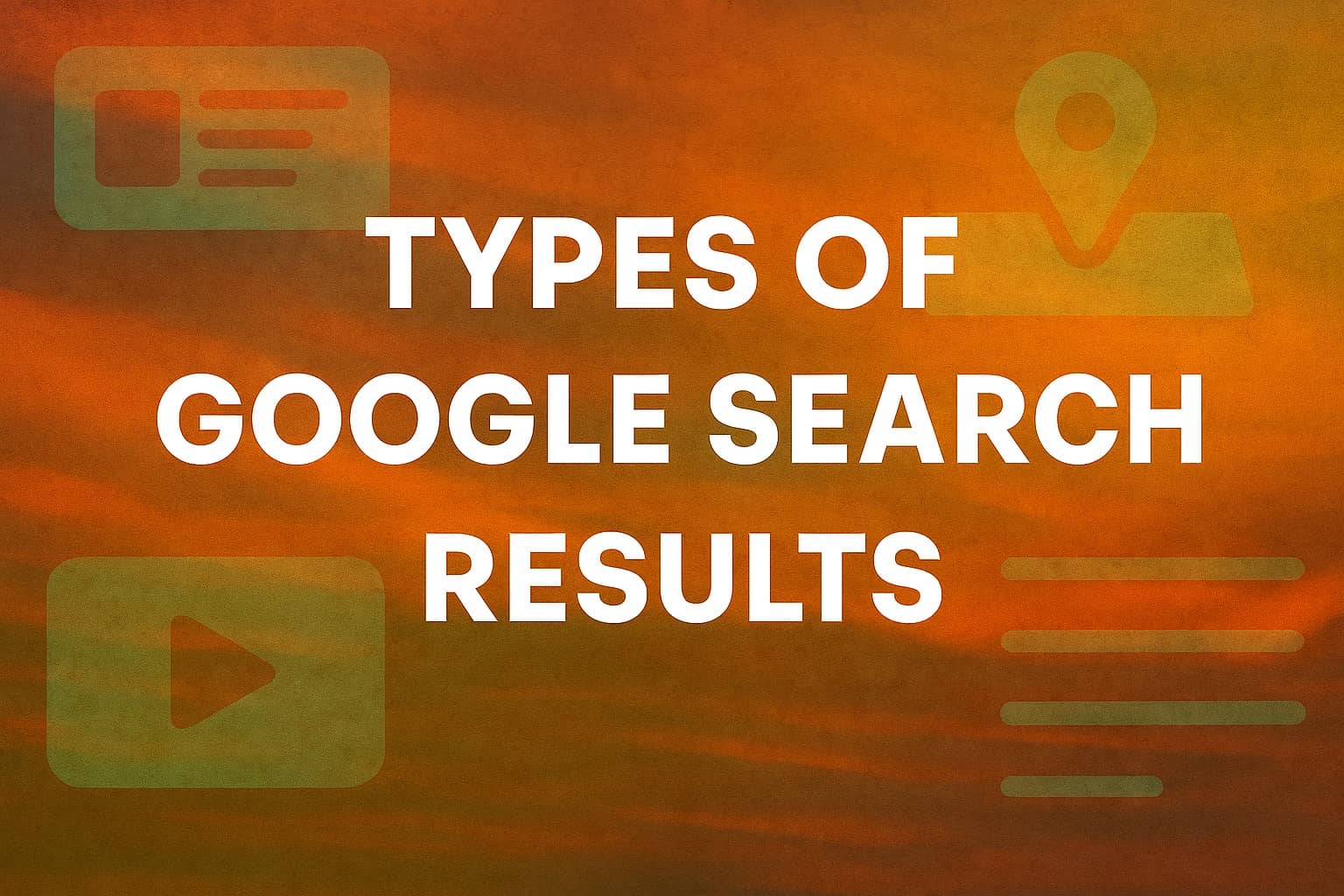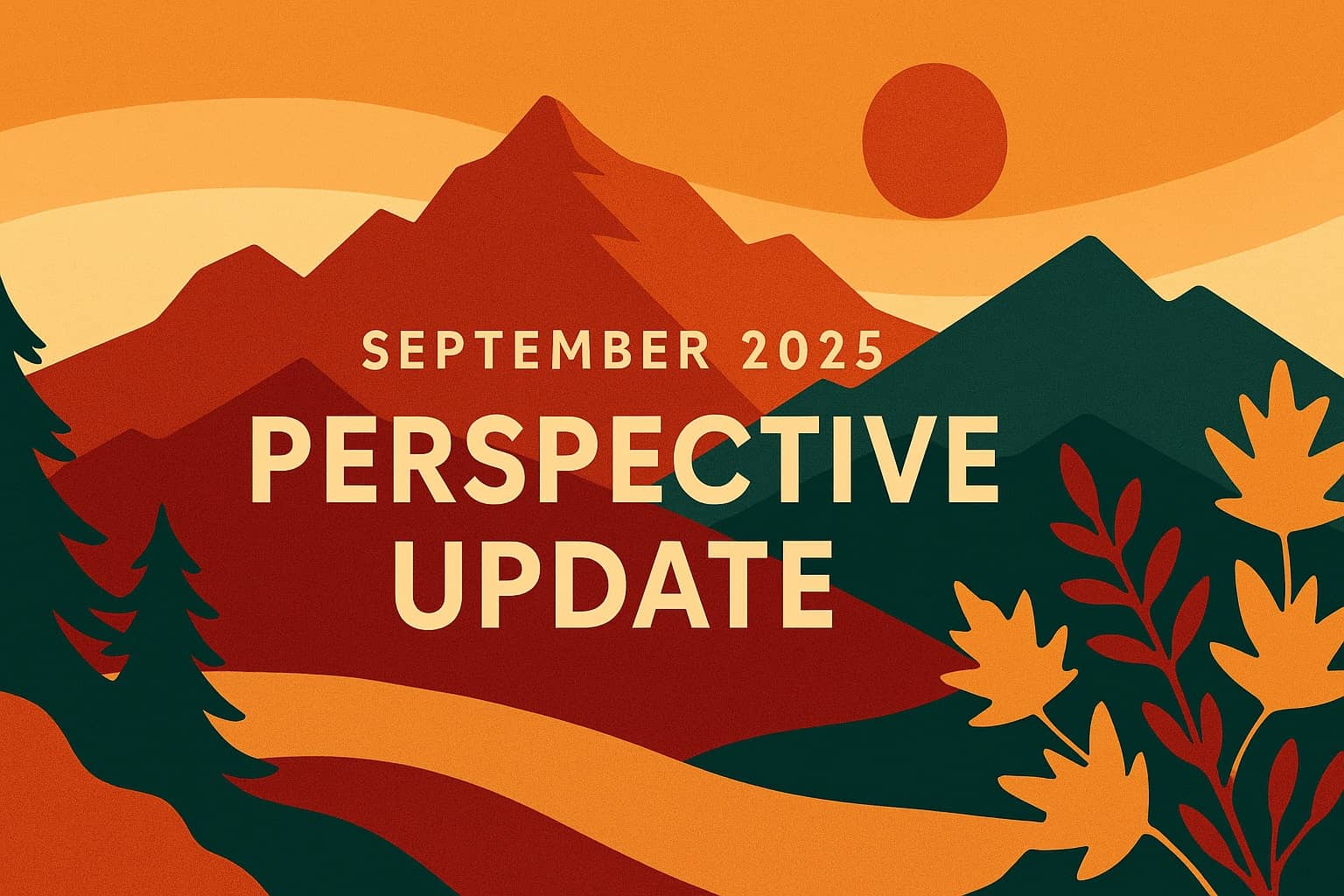table of contents
- Different Types of Google Search Results: The 2025 SERP Overview – Types, Triggers, and User Impact
- Introduction
- Key Google SERP Features, Triggers, and Typical Content
- Organic Results
- Paid Ads
- Featured Snippets
- AI Overviews
- Knowledge Panels
- Local Packs (“3-Pack” or Map Pack)
- Image Results (Image Packs, Visual Blocks)
- Video Results
- News Boxes (Top Stories)
- Shopping Results
- People Also Ask (PAA)
- Rich Snippets
- Sitelinks
- Related Searches
- Find Results On (Discussion/External Forums Panel)
- Continuous Scrolling
- Special & Emerging SERP Features
- Visual, Algorithmic, and Behavioral Shifts
Different Types of Google Search Results: The 2025 SERP Overview – Types, Triggers, and User Impact
For search marketers, brands, and publishers, success in 2025 means relentless focus on quality, structure, diversity of format, and active participation in all of Google’s evolving SERP modules.
- Familiarity with each SERP feature and integration across content, technical optimization, and brand presence is now essential for search visibility.
- AI Overviews and features like Local Packs, News Boxes, Shopping, and People Also Ask increasingly control user paths and traffic outcomes.
- Structured data, clarity, trust signals, and adaptation to multimodal/AI search are fundamental for inclusion and relevance.
- Ongoing SERP volatility, innovations (AI Mode, preferred sources, live agents), and cross-ecosystem features require agile strategies and close monitoring.
Introduction
The landscape of Google’s Search Engine Results Page (SERP) in 2025 has undergone transformative changes, reflecting rapid advancements in artificial intelligence, deep integration of multimedia content, and a focus on user intent and engagement. What began as a static list of “blue links” is now a vibrant, interactive results page with diverse elements—organic results, paid advertisements, answer boxes, AI-powered overviews, rich visuals, shopping carousels, news aggregations, and more. Each SERP feature is engineered to serve a unique purpose, triggered by specific user queries and behaviors, and tailored to optimize both information discovery and commercial transactions.
This report offers a thorough, paragraph-driven exploration of every significant Google SERP element as of September 2025. For each result type, it covers its nature, how and when it appears, example scenarios, and its typical impact on users, content visibility, and underlying business or informational goals. A structured summary table is included to facilitate quick comparison across feature types, followed by in-depth analyses of each.
Key Google SERP Features, Triggers, and Typical Content
| SERP Feature | Main Triggers/Intent | Typical Content Displayed | Appears Where? | User Impact |
|---|---|---|---|---|
| Organic Results | Informational, navigational, transactional queries | Relevant webpages (links, summary snippet) | Main listings | High trust, main traffic source |
| Paid Ads | Commercial, high-intent, and some navigational/transactional queries | Sponsored links, ad labels, extensions | Above/below organic | Immediate exposure, fast conversions |
| Featured Snippets | Direct questions, “how to”, “what is”, definitions, step-by-step instructions | Paragraph, list, or table answer box | Top “position 0” | Fast answers, boosts authority |
| AI Overviews | Informational (esp. complex), some navigational/commercial, broad topics | AI-generated multi-source summary | Top, replaces snippet | Zero-click, decreases organic CTR |
| Knowledge Panels | People, companies, organizations, locations, well-known things/entities | Fact box, images, key data, links | Right sidebar | Brand/authority visibility, trust |
| Local Packs | Local intent/“near me”, service/business/directions queries | Map, 3 business listings, reviews | Prominent top/mid | Drives local visits/calls |
| Image Results | Visual-centric, product/recipe/celebrity/art/“picture”-based queries | Carousel/grid of images + links | Mid/top | Boosts engagement, visual discovery |
| Video Results | “How to”, reviews, entertainment, trending/visual queries | Video carousel (w/ thumbnails & snippets) | Mid/top/bottom | Drives to YouTube, increased dwell |
| News Boxes (Top Stories) | News/informational/current event/breaking queries | Latest headlines, sources, publisher logo | Mid/top, carousel | News discovery, trusted sources |
| Shopping Results | Product search, buying intent, brands, specific SKUs or comparisons | Product images, prices, seller info, ratings | Right/grid | Purchase funnel, quick price compare |
| People Also Ask (PAA) | Question-based, exploratory, ambiguous, related intent queries | Expandable FAQ accordion with answers | Mid/lower | Encourages deeper exploration |
| Rich Snippets | Recipes, events, reviews, Q&A, FAQ, products, job listings, more | Enhanced snippet (stars, prices, steps) | Varies, within organics | Improves CTR, context, trust |
| Sitelinks | Branded, domain, navigational, reputation/repeat users | Clustered sub-links under one main result | Below main result | Direct navigation to key pages |
| Related Searches | All, esp. ambiguous, broad, or exploratory queries | Query refinements, alternative phrasings | Bottom (and sometimes mid-page) | Inspires next queries |
| Find Results On | Forums/discussion/long-tail/community queries | External platform links (Reddit, Quora, etc.) | Mixed, mid | Sends traffic off Google, diversity |
| Continuous Scrolling | Mobile and some desktop broad queries | More results revealed w/out page click | All organic | Increases time on SERP, less page 2 |
Organic Results

Keyword - "United Nations History"
Organic results remain the backbone of the Google SERP, even in 2025. These are the algorithmically ranked, non-paid links to websites most relevant to the user’s query. These organic results are a type of web result—a Google search listing that typically displays a clickable title, short meta description (snippet), URL, and may include visual elements like sitelinks, attribution, and other rich attributes. Despite pervasive SERP features, organic positions continue to drive the majority of search clicks across nearly all industries.
Organic results are most likely to dominate simple informational queries (e.g., “banana bread recipe,” “United Nations history,” “how to save a PDF”), navigational queries (“Harvard University”), and some long-tail searches that don’t initially trigger specialized SERP features. Sophisticated algorithms now more deeply assess intent, topical authority, site E-E-A-T (Experience, Expertise, Authoritativeness, and Trustworthiness), freshness, and user engagement to determine which web pages appear, and in what order.
While organic listings are trusted and deliver sustained, long-term website traffic, their real estate on the SERP is increasingly encroached upon by AI overviews, paid ads, featured snippets, and visual content blocks. This “further down the page” effect is especially pronounced for head terms and commercial queries as Google prioritizes instant answers, commerce, and engagement features. Still, a #1 organic result typically achieves a materially higher click-through rate (CTR) than even the best-placed ad, especially for users explicitly seeking non-sponsored information.
Paid Ads

Keyword - "Personal Injury Lawyer Vail"
Paid advertisements (Google Ads/PPC) provide immediate, top-of-SERP exposure for advertisers targeting high-intent or commercial queries. They are most likely to appear for searches related to products, services, brands, or local intent, and can occupy up to four positions at the top and several more at the bottom of the page on desktop (and two-plus on mobile).
Paid ads are marked by a small “sponsored” label and may include sitelinks, star ratings, product images, callouts, and more. In 2025, blending between paid and organic results is stronger than ever, with ads styled to match organic snippets—maximizing clicks and minimizing user ad avoidance. Current statistics indicate that roughly 6% of Google clicks go to paid ads, though this number rises for high-commercial-intent searches and certain verticals (arts/entertainment, legal, e-commerce, etc.).
Advancements in Google’s ad systems include smart automation, Performance Max campaigns, advanced audience targeting, and deep integration with Shopping and Maps results. Paid ads now increasingly coordinate with AI-driven SERP features, sometimes even appearing as “sponsored” AI answers or shopping recommendations, further blurring lines between advertising and native content.
Despite increasing average costs-per-click (CPC)—now $5.26 across industries and much higher in verticals like legal—paid search remains a vital lever for immediate visibility, especially when organic results are crowded out or slow to rank.
Featured Snippets
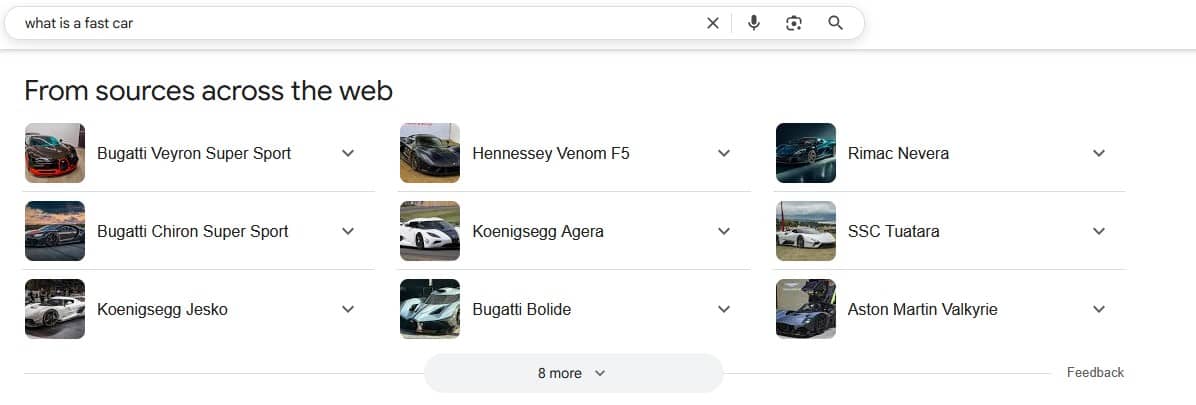
Keyword - "What is a Fast Car"
Featured snippets are concise answer boxes that appear at the very top of many SERPs, commonly known as “position zero.” They directly answer the user’s query by displaying a summary paragraph, list, or table pulled from a relevant webpage, with a link to the full source. Featured snippets especially dominate question-based queries (“what is serotonin?”, “how to change a car tire?”, “best programming languages”) and boast high visibility and click-through rates.
Google may format featured snippets as:
- Paragraphs: Definitions, explanations, or quick facts.
- Lists (ordered/unordered): Step-by-step instructions, rankings, or features.
- Tables: Comparisons, schedules, or pricing information.
Their selection is heavily influenced by content structure: well-organized headings, direct answers, concise language, and proper HTML markup all increase snippet eligibility. Voice assistants (Google Assistant, smart speakers) often read these snippets aloud, amplifying their importance for visibility.
For publishers, featured snippets are a double-edged sword—they provide massive exposure and traffic opportunities but may result in zero-click searches, especially when users’ needs are fully met by the snippet itself. Optimizing content for featured snippets (concise answers, formatting, and FAQs) remains a strategic priority.
AI Overviews
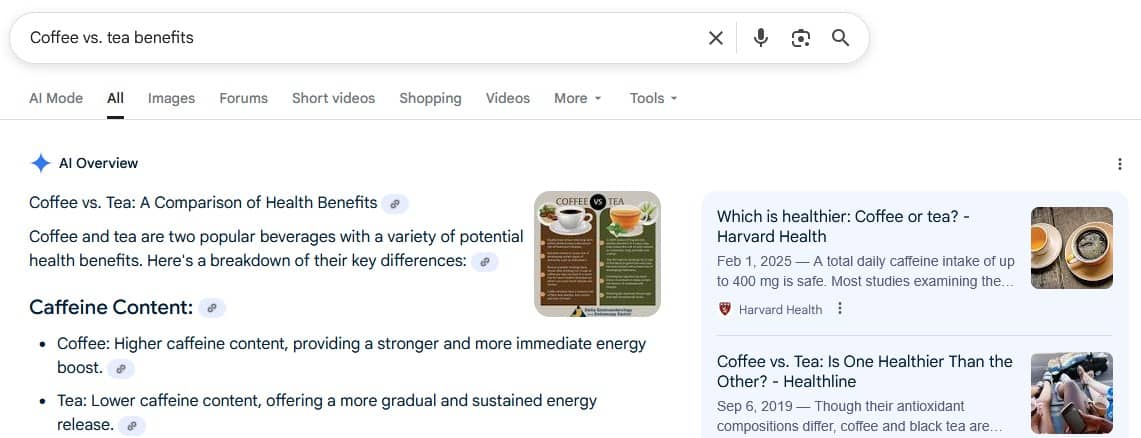
Keyword - "Coffee vs. Tea Benefits"
AI Overviews (sometimes called SGE/AIO or Generative Search) are the defining new feature of the Google SERP in 2025. Rolled out progressively since 2024, AI Overviews are machine-generated summaries that synthesize information from multiple sources into a single, conversational answer block at the very top of the result page. These answers may include text, bullet points, citations, and even images or charts.
AI Overviews appear primarily for:
- Complex informational queries: “How does quantum computing work?” or “Best strategies to save on home energy costs”
- Comparative or broad-topic queries: “Coffee vs. tea benefits,” “How to choose a domain name”
- Some navigational and commercial queries: Coverage is gradually expanding as models improve
AI Overviews have a transformative impact: they drive up zero-click behavior (users obtain information without clicking out), reduce organic result CTR by over 30% in some categories, and introduce volatility as sources cited can change rapidly and are less likely to come directly from the “top 10” organic results than before. Importantly, these overviews are designed to be more helpful by providing users with quick, consolidated answers tailored to their queries. The underlying generative models (such as Gemini 2.5) draw on Google’s vast Knowledge Graph, web pages, and real-time data, but their output sometimes includes inaccuracies, hallucinations, or overly simplistic responses—a point of criticism noted by experts and publishers alike.
For many industries, notably health, science, politics, and e-commerce, the spread of AI Overviews means content creators must now optimize not just for classic ranking factors but also for being referenced in trustworthy, authoritative, and clearly structured snippets. AI Overviews reward sites with depth, clarity, and consistent schema markup, and their prominence on the SERP is only expected to grow.
Knowledge Panels
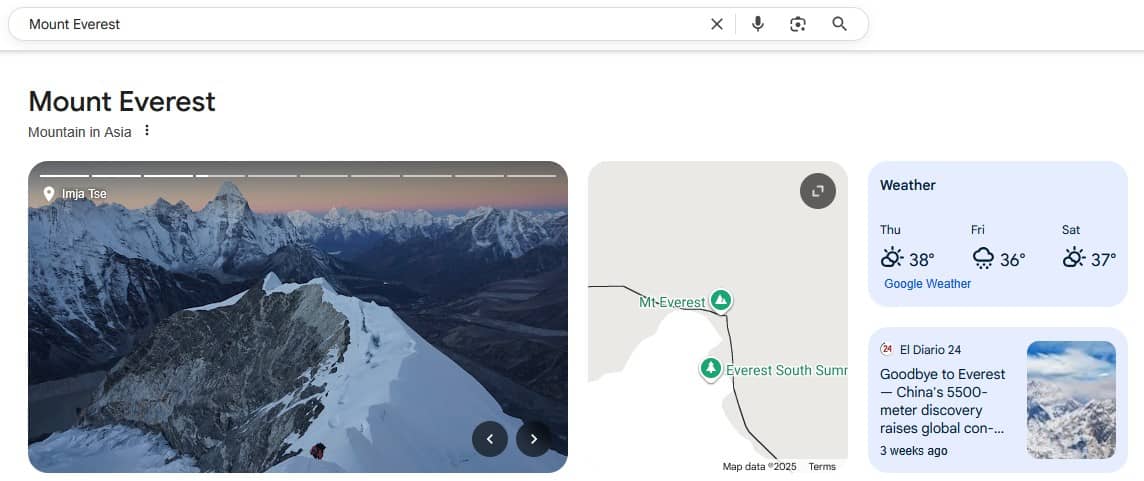
Keyword - "Mount Everest"
Knowledge panels are right-side information boxes showing key facts about people, organizations, places, or things, derived from Google’s Knowledge Graph engine. They answer navigational, fact-based, and entity-specific queries (e.g., “Barack Obama,” “Tesla Motors,” “Mount Everest”), giving users a concise, authoritative summary without leaving the SERP.
Typical content in a knowledge panel includes:
- Name, image, and basic facts (“born: August 4, 1961”)
- Key details (biography, CEO, founder, products, stock price)
- Social media and related links
- A picture carousel/panel for prominent people/organizations
- Direct links to official website or Wikipedia
- Source information to enhance credibility and transparency for users
Knowledge panels appear predominantly on desktop but are visible on mobile as well, prioritized for named entities and searches with high “brand” recognition. Google regularly updates these panels with factual changes, authoritative sources, and, where possible, feedback from verified representatives.
For individuals and brands, achieving a knowledge panel is a mark of credibility and often assists with visibility in AI Overviews. They represent a trust signal for users, directly shaping perception and reducing the need for further research. Panels can be claimed and managed by the entity involved, ensuring accurate and up-to-date presentation.
Local Packs (“3-Pack” or Map Pack)
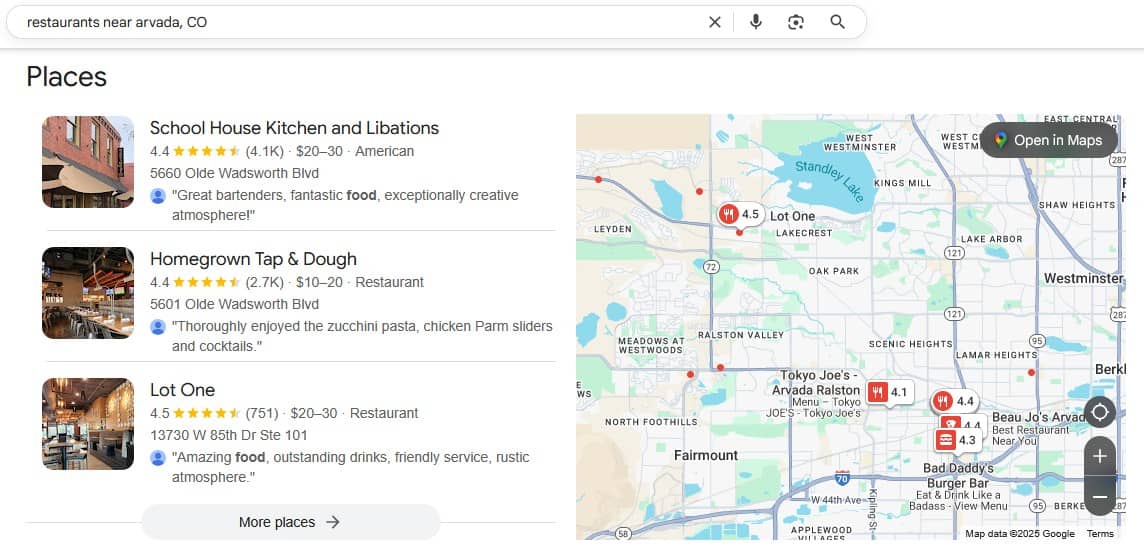
keyword - "Restaurants Near Arvada, CO"
The Local Pack is a map-based listing of three prominently featured businesses matching a user’s local intent and proximity, with results drawn from Google Business Profiles (formerly Google My Business). These are a type of local results specifically designed to surface businesses relevant to the searcher’s location. Typical triggers include:
- Explicit local searches: “coffee shop near me,” “dentist Brooklyn”
- Service intent queries: “car repair” (from a mobile device or local IP)
- Navigational searches for businesses with a physical presence
The Local Pack displays the business name, rating, address, hours, map pin, and sometimes images or calls-to-action. In 2025, pack rotation ensures that more businesses get exposure, as the actual three shown may differ with each refresh or user action, reflecting attempts to prevent monopolization and offer diversity of choice.
Key impacts include:
- Dominance of above-the-fold real estate (even above ads or organics)
- High CTR, especially for “near me” searches (with as much as 44% of all local searchers clicking a Local Pack entry compared to 19% for paid and 29% for organic results)
- Substantial influence on customer actions—calls, visits, and directions originate directly from the pack
The visibility of businesses in the Local Pack is highly dependent on the searcher’s location, which determines which local results are shown. Local SEO success now mandates a robust, accurate Google Business Profile, positive reviews, local backlinks, authority signals, and up-to-date information. Recent changes also place a premium on E-E-A-T, mobile optimization, and user engagement signals in local rankings.
Image Results (Image Packs, Visual Blocks)
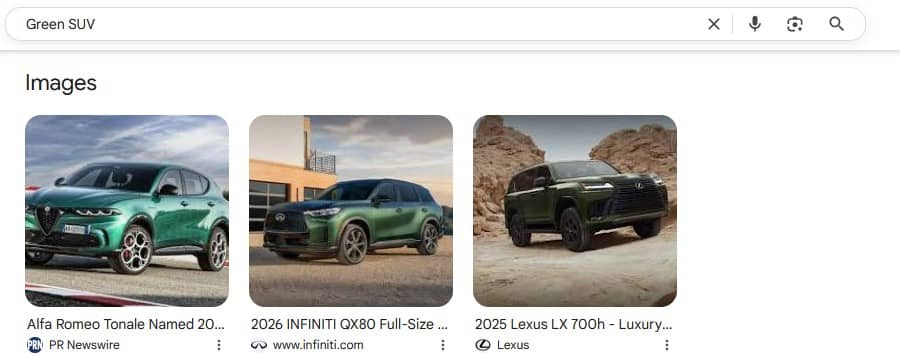
Keyword - "Green SUV"
The Local Pack is a map-based listing of three prominently featured businesses matching a user’s local intent and proximity, with results drawn from Google Business Profiles (formerly Google My Business). These are a type of local results specifically designed to surface businesses relevant to the searcher’s location. Typical triggers include:
- Explicit local searches: “coffee shop near me,” “dentist Brooklyn”
- Service intent queries: “car repair” (from a mobile device or local IP)
- Navigational searches for businesses with a physical presence
The Local Pack displays the business name, rating, address, hours, map pin, and sometimes images or calls-to-action. In 2025, pack rotation ensures that more businesses get exposure, as the actual three shown may differ with each refresh or user action, reflecting attempts to prevent monopolization and offer diversity of choice.
Key impacts include:
- Dominance of above-the-fold real estate (even above ads or organics)
- High CTR, especially for “near me” searches (with as much as 44% of all local searchers clicking a Local Pack entry compared to 19% for paid and 29% for organic results)
- Substantial influence on customer actions—calls, visits, and directions originate directly from the pack
The visibility of businesses in the Local Pack is highly dependent on the searcher’s location, which determines which local results are shown. Local SEO success now mandates a robust, accurate Google Business Profile, positive reviews, local backlinks, authority signals, and up-to-date information. Recent changes also place a premium on E-E-A-T, mobile optimization, and user engagement signals in local rankings.
Video Results
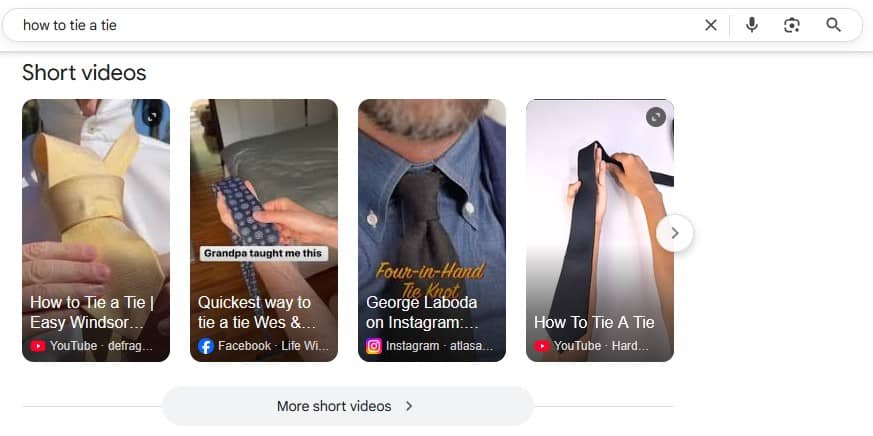
Keyword - "How to Tie a Tie"
Video carousels or blocks appear for queries involving instructions, entertainment, product reviews, learning, or anything visual/audible (“how to tie a tie,” “iPhone 17 review,” “Taylor Swift concert”).
They display a scrolling carousel or series of video thumbnails, titles, sources (usually YouTube or trusted sites), duration, and sometimes segment time stamps (jumping directly to the answer moment). Both general videos and YouTube videos are commonly featured in these carousels. They commonly appear:
- In the upper/mid section of the SERP
- Above organic results for certain how-to or trending queries
- Integrated with news or shopping (e.g., “best electric bicycle”)
Video results boost CTR, dwell time, and position brands as authorities. Optimizing videos, including YouTube videos, with proper titles, engagement, schema (VideoObject), and closed captions improves the likelihood of inclusion. They are particularly vital for voice search and mobile-dominant audiences.
News Boxes (Top Stories)
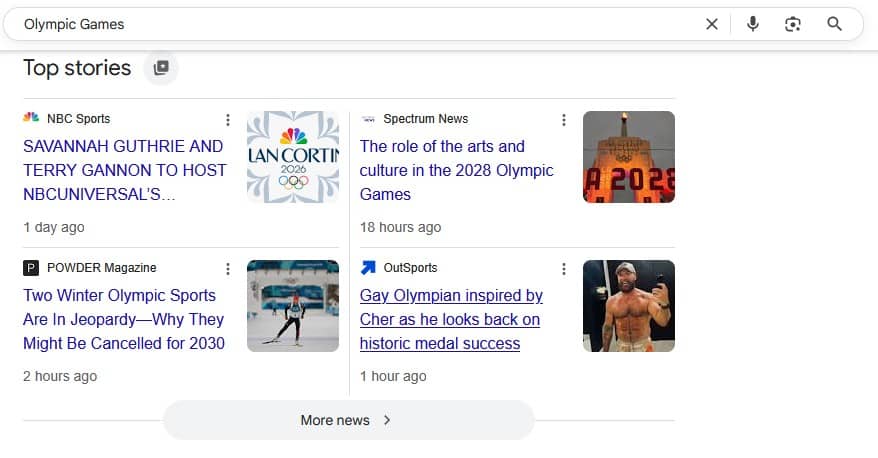
Keyword - "Olympic Games"
Top Stories boxes cluster timely, trusted news headlines related to the search query, displayed as either a horizontal carousel (on mobile) or grid card (on desktop). They appear for:
- Breaking news or current event queries (“election results,” “hurricane update”)
- Trending public issues, sports, or high-interest topics
News boxes show:
- Source logo and publication
- Headline and timestamp
- Image thumbnail
In 2025, users in the U.S. and India can now tailor the Top Stories box with preferred sources—boosting their favorite news sites for personalized news feeds. This represents a substantial change in news consumption behavior, with possible risks for ideological echo chambers.
Publishers’ inclusion is governed by Google’s Publisher Center and News SEO best practices (timeliness, accuracy, page structure, AMP, schema, and authority). Meeting Google News guidelines is essential for being featured in news boxes and Top Stories, as Google News emphasizes quality standards for inclusion in its search results. Top Stories is a dominant traffic driver for news media, though inclusion criteria have grown stricter amid misinformation concerns.
Shopping Results
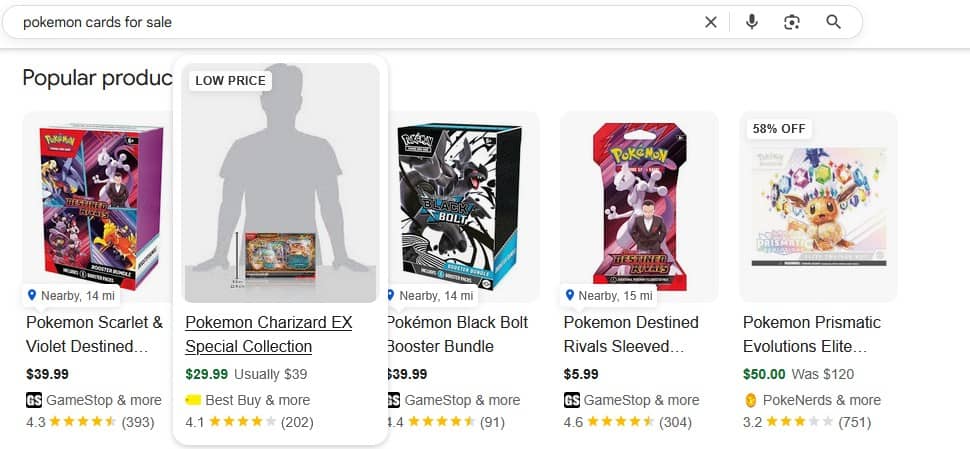
Keyword - "Pokemon Cards For Sale"
Google Shopping features are now deeply integrated into the core SERP, triggered by product, brand, and buying-intent queries (“best wireless earbuds,” “Nike Air Max 2025,” “laptop deals”). They display:
- Product images, price, title, and seller
- Ratings and availability (these ratings are often shown as review stars to help users quickly assess product quality)
- Visual carousels, grids, or right-sidebar blocks
2025’s Google Shopping is AI-driven, with Overviews sometimes replacing traditional product card grids. Enhancements include:
- Virtual try-on experiences
- Price tracking and notifications
- Direct checkout capabilities
- Merchant badges to indicate trusted sellers
Shopping dominates e-commerce search, capturing up to 85% of all retail search ad clicks, with 76% of retail paid search budgets allocated to Google Shopping campaigns. Mobile usage is especially high (65%+). For advertisers and merchants, maintaining high-quality product feeds, accurate pricing, structured data, and robust reviews is essential to visibility and conversions.
People Also Ask (PAA)
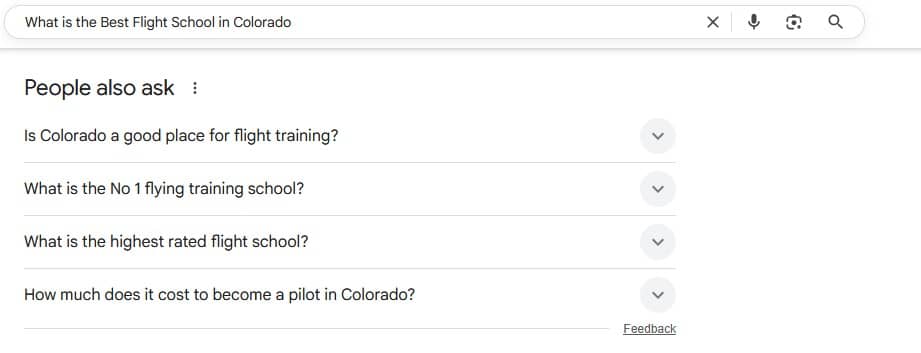
Keyword - "What is the Best Flight School in Colorado"
The “People Also Ask” box is a dynamic, expandable accordion list of related questions and answers surfaced by Google’s AI, typically appearing for question, explainer, or ambiguous queries (“what is blockchain,” “how does mortgage work,” “should I buy a hybrid car”). Opening one answer often spawns more related questions below.
PAAs are drawn from indexed webpages and, since late 2024, increasingly include AI-generated answers for questions lacking direct citations (now in ~13% of PAAs). They help users explore a topic more deeply from multiple angles, often displacing traditional organic results further down. The questions shown in PAAs are frequently influenced by what users have previously searched for or are currently searching, reflecting related queries and search history.
For SEO, being featured in PAA dramatically increases the visibility and authority of content. Optimizing by directly addressing common questions with concise, structured answers and including FAQ schema increases eligibility. As “People Also Ask” expands, it serves as both a user educational resource and a competitive content battleground.
Rich Snippets
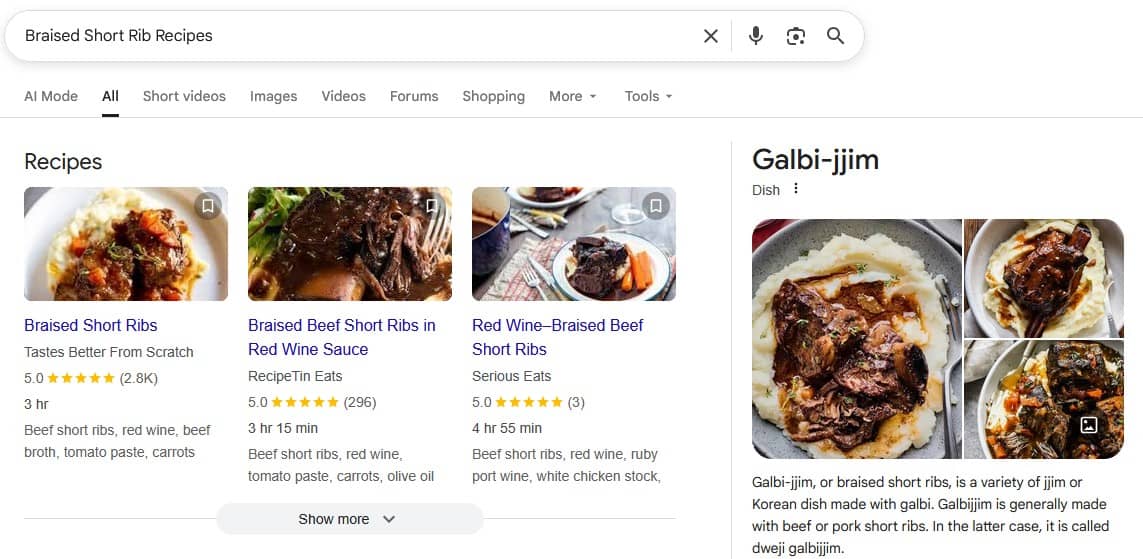
Keyword - "Braised Short Rib Recipes"
Rich snippets are enhanced organic listings that display extra data beyond the normal title and description—such as star ratings, prices, recipe steps, event dates, job stats, and product availability. These are a type of rich results that can include various visual enhancements like images, review stars, and other interactive elements. They are powered by structured data markup (schema.org) embedded in web pages.
Rich snippets commonly appear for:
- Recipes
- Reviews/products (often featuring review stars as a prominent visual element in these rich results)
- Events
- FAQs/q+a
- Software/apps
- Jobs or local business pages
These enhancements increase CTR (by 25–82% in some cases), provide instant context, and help sites stand out in otherwise crowded SERPs. Implementation of accurate, complete, and up-to-date schema is increasingly vital, not just for Google, but also for surfacing in AI Overviews and answer engines.
Sitelinks
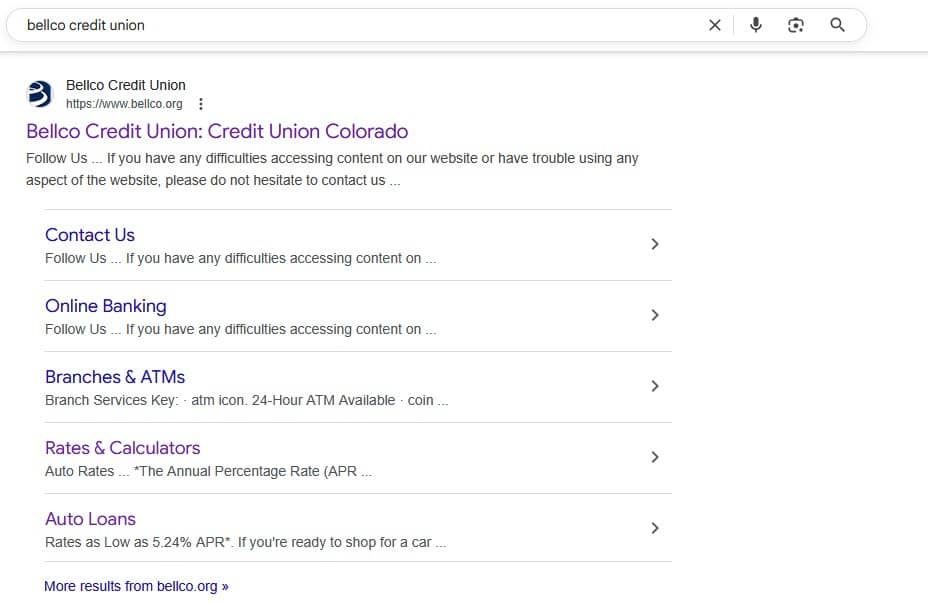
Keyword - "Bellco Credit Union"
Sitelinks are clustered subpage links shown under a website’s primary listing, primarily for branded or high-authority navigational searches (“Starbucks,” “Amazon,” “NY Times”). These links are grouped from the same domain to improve navigation and user experience in search results.
They provide shortcuts to key website sections (“About,” “Login,” “Products,” etc.), boost trust, expand SERP real estate, and make it easier for users to get where they want fast. Sitelinks are automated by Google but can be influenced through clear site structure, proper navigation, and internal linking.
Variants include:
- Main sitelinks (multiple rows, each with a snippet)
- One-line sitelinks (horizontal links under the main URL)
- Sitelinks search box (lets users search the site directly from the SERP)
While site owners cannot select which sitelinks appear, optimizing the site for clarity and logical organization increases likelihood of visibility.
Related Searches
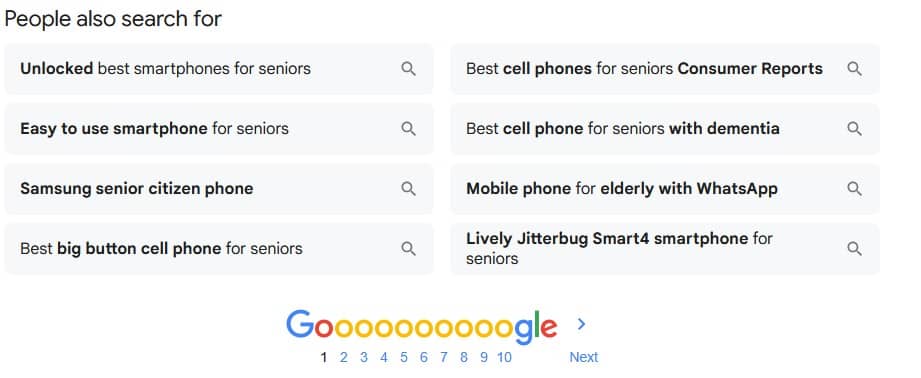
Keyword - "Best Smartphones for Seniors"
At the bottom (and sometimes middle) of the SERP is the “Related Searches” box, which offers alternative queries, suggestions, or refinements based on patterns and similar searches (“smartphone reviews 2025,” “best smartphones for seniors,” “budget smartphones India”). These suggestions are generated from patterns in user searches and help guide users to more relevant information. Related Searches guide users to iterate or clarify their intent, serve as a discovery tool, and keep engagement on Google.
For search marketers, analyzing Related Searches informs keyword expansion, content planning, and competitive opportunity.
Find Results On (Discussion/External Forums Panel)
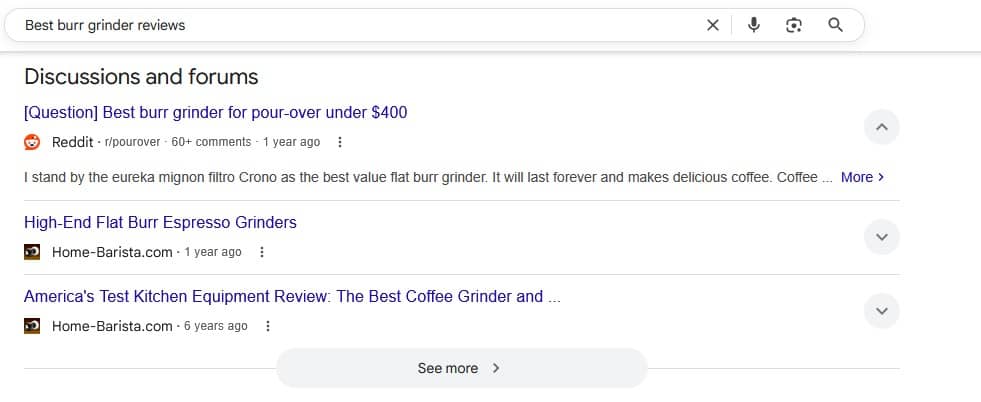
Keyword - "Best Burr Grinder Reviews"
One of the newer features, the “Find Results On” panel, suggests users explore external discussion platforms such as Reddit, Quora, StackOverflow, or niche forums for more opinions, reviews, and community-generated knowledge. This feature redirects users away from Google’s own index for broader social discovery and has had measurable impacts: major platforms have recorded millions more clicks, even as their traditional organic rankings declined.
Triggers include:
- Forum/discussion-seeking queries
- “Reviews,” “Reddit,” or “forum” appended to product or advice searches
- Long-tail or opinion queries where Google’s web index is sparse
This panel underscores Google’s embrace of broader digital ecosystems and the rise of user-generated content’s role in search.
Continuous Scrolling
Continuous scrolling, now present across mobile and (increasingly) desktop, replaces traditional pagination with an infinitely expanding list of results as users scroll down. This means fewer clicks to page 2 or page 3, allowing more organic and mixed SERP features to be viewed in a single stream. It also reorders CTR patterns, making classic “first-page” targeting less strictly bounded.
Special & Emerging SERP Features
AI Mode and Full-Screen Experiences
With the launch of full “AI Mode,” searchers in 2025 can toggle between classic search and immersive AI-powered conversations, including live, agentic (“do it for me”) functionalities. These include:
- Deep Search (advanced research with source control)
- Live multimodal chat (text + images + real-time camera)
- Interactive summaries, AR overlays, dataset visualizations, and instant booking/checkout for commerce.
This modular and real-time AI capacity is reshaping how users learn, decide, and transact in search. Voice, camera, and virtual agent interactions are rapidly mainstream.
Preferred Sources for News
A 2025 update allows users to set “preferred sources” for Top Stories boxes, placing their trusted news, blogs, or publishers front and center across SERPs. It’s available in English for the US and India and raises new questions about filter bubbles and diversity.
Visual, Algorithmic, and Behavioral Shifts
Google’s 2025 SERP is defined not just by what appears, but by how it appears. Over 65% of first-page results now have significant visual elements—images, product carousels, knowledge panels, or map packs. Each feature aims to minimize friction, offer instant gratification, and encourage deeper engagement—all shaped by constant algorithmic volatility and AI-aided personalization. Understanding the different search result types and features on Google SERPs is essential for effective SEO, as these elements influence visibility, click-through rates, and user engagement.
Stakeholders must understand that SERP composition and volatility are higher than ever, with AI Overviews, Knowledge Panel citations, and rich snippets constantly evolving based on core updates, user intent signals, and model retraining. Google ranks websites and content based on a combination of factors, including the presence of top keywords and relevant content. Optimizing the page’s content by including keywords and the same keywords that users are searching for is crucial for improving relevance and ranking. Web crawlers play a key role in indexing and understanding structured data, which helps Google identify and display rich results. Monitoring, benchmarking, and adapting SEO/SEM strategies across multiple SERP features is now non-optional for sustained digital success.
